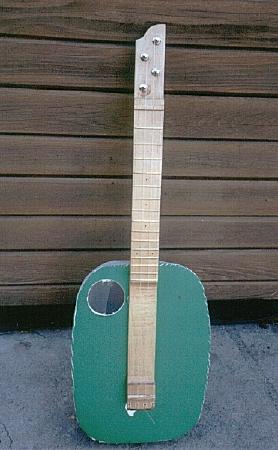
HotDamm! It's even microwave safe! |
Parting Notes
Obviously, some very serious compromises were made in the interest of keeping this instrument simple. However, none of these compromises keep it from being absolutely functional. A traditionally constructed instrument would probably sound sweeter, last longer and look nicer. That is, if you have the money, tooling and skill to build it properly. That being said, this instrument can be a surprisingly fine performer. As constructed, it has decent volume, stays in tune and plays well.
The food container I used makes for a deeper soundbox than the average uke. And the mountain dulcimer style neck places the strings higher from the soundboard than the average uke. Both these factors can take some getting used to for the experienced uke player. While unusual, they do offer some advantages, such as fuller tone and better clearance when playing with a plectrum.
While the soundboard material I used works well, don't be afraid to experiment with other materials. I suspect just about anything that is that is stiff and very lightweight will do. I'm gonna try some courrugated sheet plastic, the type used in a manner very much like corrugated cardboard, and some cedar shingle material from a construction site.
What seems promising about this overall design is that it seems it may scale well. That is, I suspect one could easily make other instruments using very similar configurations, simply adjusting the neck and body sizes accordingly. Imagine a Mexican vihuela (as if that instrument isn't humble enough already), or a guitar, or a mandola, etc. If you have a bolt-on electric guitar neck sitting around, hack out a stick body/bridge for it and affix it to appropriately sized soundbox. Of course, if you make a metal-stringed instrument, wooden frets just won't do. Try cable ties (thanks, Mirjan Milovanovic!). Sure, they'll wear out, but they're so easy to replace. Posterboard is cheap and plastic containers come in a variety of sizes. Then tell me how it works. |




